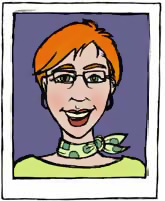How People Learn: Presenting the Learning Theory and Inquiry Cycle on Which the IRIS Modules Are Built (Archived)
Wrap Up
 Let’s review Kellie’s progress this semester. With Amani’s help, she has learned a lot about How People Learn, and now knows that her instruction should incorporate learner-centered, knowledge-centered, assessment-centered, and community-centered components.
Let’s review Kellie’s progress this semester. With Amani’s help, she has learned a lot about How People Learn, and now knows that her instruction should incorporate learner-centered, knowledge-centered, assessment-centered, and community-centered components.
In order to make her classes learner-centered and to render her students’ thought processes visible to them, Kellie decides to learn about each student’s background knowledge, interests, and cultural values and beliefs. By doing this she will be able to discover any misconceptions or inaccurate information that may interfere with their knowledge acquisition. She will then be able to address these misconceptions throughout the semester.
The knowledge-centered component of instruction is the easiest for Kellie to plan for, as it corresponds easily to the traditional means of instruction to which she is accustomed. Still, Kellie realizes that she, as an “expert” in her field, might assume a lot of knowledge that her novice students would not yet have acquired. Furthermore, she recognizes that her conditionalized knowledge in certain areas needs to be transmitted to her students.
 Before starting at the university, Kellie already knew that she could use class quizzes and tests as an ongoing means of formative assessment for herself, to monitor how well her students were learning the course content. But she now also realizes that these can be used as tools for her students as well, as they acquire the metacognitive skills necessary to monitor and improve their own learning. Furthermore, she plans to incorporate small-group study sessions throughout the semester as another way to assess and enhance student learning.
Before starting at the university, Kellie already knew that she could use class quizzes and tests as an ongoing means of formative assessment for herself, to monitor how well her students were learning the course content. But she now also realizes that these can be used as tools for her students as well, as they acquire the metacognitive skills necessary to monitor and improve their own learning. Furthermore, she plans to incorporate small-group study sessions throughout the semester as another way to assess and enhance student learning.
These study sessions will also help Kellie to incorporate more community-centered practices into her instruction. Within these small groups, the students will learn together and give each other feedback. When a student struggles with a concept, other students may be able to explain the content in different ways from those Kellie uses. Not only will the struggling students benefit but Kellie herself can also learn from the experiences, learning alternate methods for presenting the material. These discussions should also result in students’ gaining a more in-depth understanding of the material, allowing them to address more challenging issues in class.
During a brainstorming session, Kellie and Amani develop the following table, which lists the different methods for incorporating the four HPL lenses into her instruction.
Understand how students’ cultural beliefs and values might influence their learning.
| Learner- centered lens |
Knowledge- centered lens |
Assessment- centered lens |
Community- centered lens |
| Get students’ background knowledge and interests about content-related topics. | Organize instructional activities to match material to student interests and background knowledge. | Incorporate frequent information gathering through formative assessment quizzes, and activities. | Develop a classroom environment in which students feel safe to express opinions that might be different from the norm. |
| Have students relate previous experiences about relevant material. | Encourage students to build expertise for a deeper understanding of the material. | Help students use formative assessment feedback to develop metacognitive skills. | Obtain feedback from students on what they feel is important to learn within the framework of the course. |
| Teach students to use newfound expertise to transfer learning to applicable situations. | Hold small-group study sessions. | Develop a collaborative, instructional atmosphere based on both students’ and the instructor’s metacognitive needs. | |
| Obtain feedback from students on what they feel is important to learn within the framework of the course. | Engage in course activities to balance the promotion of understanding and skill-building. | Use summative assessments that demonstrate students’ mastery of course objectives. | Hold small-group study sessions. |
| Review incoming student knowledge and beliefs and compare them to students’ end-of-course knowledge. | Develop student skills so that they become automatic or “second nature” for students. | Obtain feedback from students on the instructor’s effectiveness. | Incorporate small-group activities into lesson plans. |
Kellie aspires to maintain a balanced learning environment in her classes, incorporating all four of the HPL lenses. She will communicate her expectations to her students, as well as elicit their expectations in return. The students will be expected to take control over their own learning rather than sitting passively in class and memorizing pages of notes for end-of-term tests. They will also be expected to work with each other to enhance their knowledge acquisition.
Kellie has used a STAR Legacy Module to learn about the HPL lenses. Consequently, she decides to use other IRIS STAR Legacy Modules for instructional tools with her students and discusses options for assigning these modules with Amani (i.e., full in-class use, partial in-class use, or use as homework). She decides to grade the modules by using the built-in Assessment questions and will use an Initial Thoughts/Final Thoughts comparison to gather formative assessment information on her students. This information will also help her gauge her effectiveness as an instructor.
After learning about HPL theory and its components, Kellie is excited about this promising instructional style. She recognizes that the HPL process will take some preparation time initially, as this method of instruction is different from anything she has ever used before. However, she looks forward to her upcoming semester and has high expectations that her students will not only achieve the necessary course objectives but also will become effective classroom practitioners.
Revisiting Initial Thoughts
Think back to your initial responses to the following questions. After working through the resources in this module, do you still agree with your Initial Thoughts? If not, what aspects of your answers would you change?
How can faculty present important content to be learned in ways that improve student learning?
Is there a tool or format that helps faculty organize effective instruction?
Are there modules available for faculty use that are based on learning science research and, therefore, really do increase student learning? If so, how can faculty use them?
When you are ready, proceed to the Assessment section.